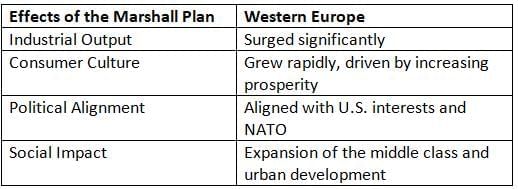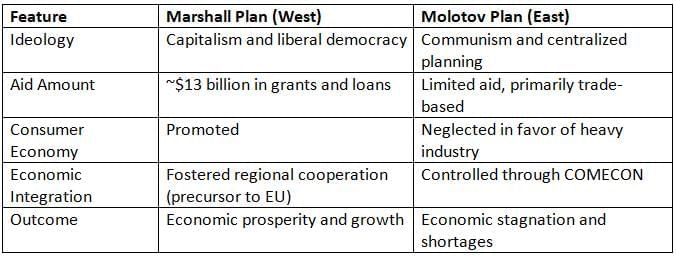Rebuilding Europe After World War II Chapter Notes | AP European History - Grade 9 PDF Download
| Table of contents |

|
| Introduction |

|
| The Marshall Plan and the Western Economic Miracle |

|
| The Soviet Response: The Molotov Plan |

|
| Comparing the Two Plans |

|
| Broader Significance |

|
Introduction
Following World War II, Europe was left in devastation, with cities reduced to rubble, industries in collapse, and infrastructure heavily damaged. Both victorious and defeated nations grappled with economic hardship, political instability, and humanitarian crises. As the Cold War emerged, two opposing visions for rebuilding Europe took shape: one driven by the capitalist United States and the other by the communist Soviet Union. These contrasting approaches not only influenced the speed and success of Europe’s recovery but also deepened the ideological rift that defined the Cold War era. This chapter notes examines the Marshall and Molotov Plans, their economic and cultural impacts, and how they solidified the East-West divide, influencing Europe’s post-war identity and the bipolar world order.
The Marshall Plan and the Western Economic Miracle
To counter the rising influence of communism in post-war Europe, the United States introduced the Marshall Plan in 1948, officially termed the European Recovery Program.
Key Features of the Marshall Plan
- Delivered over $13 billion (equivalent to roughly $100 billion today) in economic assistance to Western and Central European countries.
- Provided loans, grants, food, fuel, and machinery to restore industry and rebuild infrastructure.
- Encouraged recipient nations to collaborate economically, promoting long-term regional integration.
Economic Miracle: The Marshall Plan catalyzed a prolonged period of rapid economic growth in nations like West Germany, France, and Italy, often called the "Wirtschaftswunder" or “economic miracle.”
Outcomes
- Boosted industrial output and stabilized national currencies.
- Reduced unemployment rates and spurred consumer spending.
- Enhanced political stability and strengthened pro-Western alliances.
- Reinforced capitalist democratic systems as effective models for recovery.

The Marshall Plan not only revitalized economies but also transformed culture, with consumer goods, appliances, cars, and American influences becoming emblems of progress and affluence.
The Soviet Response: The Molotov Plan
In opposition to the U.S. initiative, the Soviet Union rejected the Marshall Plan, perceiving it as an effort to extend American dominance in Europe. Instead, the USSR launched its own initiative in 1947, known as the Molotov Plan.
Features of the Molotov Plan
- Provided aid to Eastern European nations under Soviet influence, including Poland, Czechoslovakia, Hungary, Romania, and Bulgaria.
- Emphasized centralized economic planning, mutual trade agreements, and industrial growth based on communist principles.
Limitations
- Lacked the financial scale and resources of the Marshall Plan.
- Prioritized resource extraction and heavy industry, sidelining consumer goods production.
- Maintained strict Soviet oversight, stifling innovation and political freedom.
COMECON (Council for Mutual Economic Assistance): Established in 1949, it served as the organizational framework for the Molotov Plan, managing trade and production among Eastern Bloc countries, though with significantly less success than Western cooperative efforts.
Long-Term Consequences
- Eastern Europe fell behind Western Europe in economic progress.
- Chronic shortages of consumer goods and lower living standards persisted.
- Growing resentment toward Soviet dominance in satellite states fueled unrest, such as the 1956 Hungarian uprising and the 1968 Prague Spring.
Comparing the Two Plans

Broader Significance
- The contrasting recovery strategies of the United States and the Soviet Union established the foundation for the bipolar world order that characterized the latter half of the 20th century.
- They also entrenched the economic and cultural divide between Eastern and Western Europe, a separation that persisted until the fall of communism in the late 1980s.
- The Marshall Plan’s success showcased the potential of capitalist economic development linked to consumer culture and democracy, shaping Western Europe’s post-war identity and laying the groundwork for future economic integration, such as the European Economic Community and, later, the European Union.
Key Terms
- Bulgaria: A Southeast European nation with a rich historical and cultural heritage, Bulgaria became a socialist state under Soviet influence post-World War II, shaping its Cold War political and economic landscape, with significant migrations following the collapse of communism.
- Central Europe: A region encompassing nations like Germany, Poland, the Czech Republic, and Austria, known for its diverse cultural and political influences, playing a pivotal role in European history during times of conflict and transformation.
- Cold War: A period of geopolitical tension from post-World War II to the early 1990s between the Soviet Union and the United States, marked by ideological rivalry, proxy wars, and military competition, influencing global politics.
- Communist Nations: Countries adopting communism, where the state controls production and aims for a classless society, emerging as key players in Eastern Europe under Soviet influence during the Cold War.
- Consumerism: An ideology promoting increased consumption of goods and services, gaining prominence post-World War II, shaping economies and societal values through a focus on material wealth and lifestyle.
- Czechoslovakia: A Central European nation (1918–1993), significant in World War II, post-war reconstruction, and the Cold War’s ideological struggle, later splitting into the Czech Republic and Slovakia.
- Eastern Europe: A region including Poland, Hungary, Romania, and others, known for its diverse political and cultural history, particularly during the Cold War and post-communist transitions.
- Hungary: A Central European nation with a history shaped by fascism, communism, and post-war reconstruction, influencing its role in Cold War dynamics and European politics.
- Marshall Plan: A 1948 U.S. initiative providing economic aid to Western Europe for post-war recovery, countering communism, fostering stability, and reinforcing U.S. global influence.
- Molotov Plan: A 1947 Soviet initiative offering aid to Eastern European countries under USSR influence, countering the Marshall Plan, strengthening communist control, and fostering economic ties within the Soviet bloc.
- Poland: A Central European nation with a history of independence and occupation, playing a key role in World War II and Cold War politics, shaping modern European dynamics.
- Romania: A Southeastern European country with a complex 20th-century history, transitioning from monarchy to communism and later democracy, reflecting broader European trends during the Cold War.
- Satellite Nations: Countries under heavy Soviet influence during the Cold War, formally independent but politically and economically controlled, serving as a buffer between the USSR and Western Europe.
- Soviet Union: A socialist state (1922–1991) with a communist ideology, central to Cold War geopolitics, characterized by state-controlled economics and authoritarian rule.
- Western Europe: A region including France, Germany, and others, defined by democratic governance and economic development, shaping modern European identity during World War II and the Cold War.














